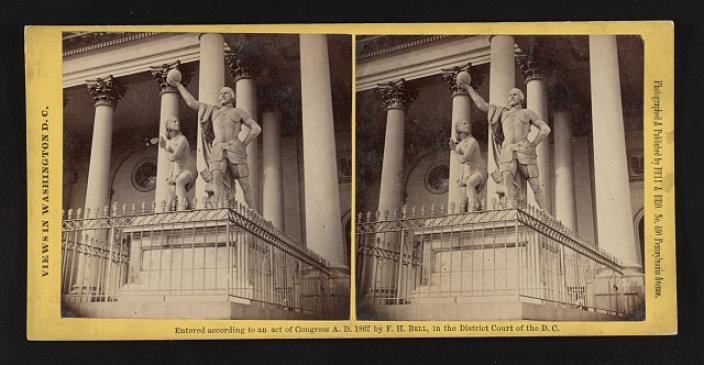The long-spanning controversy surrounding The Discovery of America and The Rescue statues situated at the east front of the Capitol building was a compilation of the amplified disapproval of the Indigenous people and their advocates that prevailed for numerous years.
The removal of the Christopher Columbus statue occurred in 1958 as the Capitol pieces that favored white colonizers received waves of mass opposition, asserting that these figures did nothing but harm the Indigenous community.
The Infamy of The Capitol’s Statues
In the late 1830s, President Martin Van Buren and Congress requested the construction of the infamous statue The Discovery of America. Made from Seravezza marble by the Italian immigrant artist Luigi Persico, The Discovery of America‘s production period spanned four years from 1840 to 1844.
The statue depicts Christopher Columbus bravely raising a globe with his right hand and a frightened Native American Indian woman, cowering in fear to his right.
Built to stand tall at the eastern wing of the Capitol, James Buchanan, an acquaintance of artist Persico, stated that the constructed figure represented the feelings of happiness Christopher Columbus felt when he surpassed his struggles at the shore, sharing to the world his discovery of America. (Source: The Capitol Dome)
Once again, the United States government commissioned American Artist Horatio Greenough, suggested by Senator William Preston, to create a companion piece of a similar nature. Greenough then produced The Rescue statue that stood with the Discovery of America at the Capitol’s entrance in 1853.
The Rescue showed an Indian man struggling against the grasp of a settler with a white child and a woman situated behind the two, fearing their lives, as a dog watched the conflict.
Despite the opposition of the many, both the statues remained standing tall at the Capitol’s entrance. Both the commissioned artists met the ideals of Congress’s intention to portray the success of the white invasive colonizer against the vulnerable Indigenous people. Moreover, as seen in the studies of historian Green Fryd, the presence of the statues significantly aided in the enactment of policies harmful to the Indigenous community. (Source: Boundary Stones)
The Celebrated and Long-Overdue Removal
Despite the Indigenous community’s long-spanning opposition towards The Discovery of America and The Rescue, the notorious statues finally gained an amplified mass refusal starting in the late 1930s, nearly a hundred years after its creation.
In 1934, the Native American Reorganization Act emphasized the oppressive acts of the white settlers, changing the treatment of white Americans toward the Native Americans.
White colonizers took away Native Americans’ best lands; broke treaties, promises; tossed them the most nearly worthless scraps of a continent that had once been wholly theirs.
Native American Reorganization Act
Another surge of resistance emerged in the 1950s as Congress started to acknowledge the sovereignty of the Indian Americans. Soon, the National Congress of American Indians demanded the ousting of the oppressive statues. Leta Myers Smart also magnified the demands of the Indigenous people through her actions and her direct criticism aimed towards the Capitol’s statues. (Source: Boundary Stones)
The American Indian is no longer, if he ever was, the blood-thirsty savage Greenough made him out to be in this group of sculpture, we feel we have to rescue the Indians from these deplorable straits.
Leta Myers Smart
Leta Smart further argued that both statues carried implications of physical & sexual violence, the brutality of historical abstraction, conquest, and subsisting settler colonialism. The collaboration of protests, the aid of American Indian organizations, and passed petitions eventually led to the removal of both statues in 1958. (Source: The Capitol Dome)
